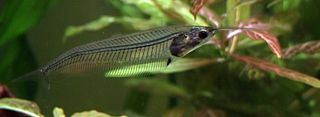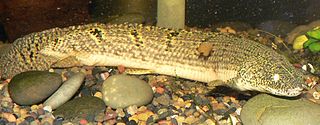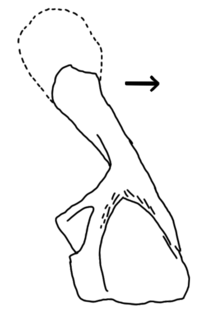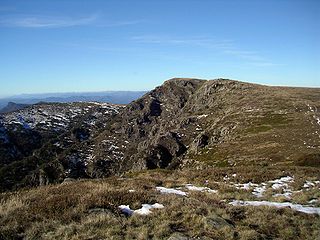This article has multiple issues. Please help improve it or discuss these issues on the talk page . (Learn how and when to remove these template messages) (Learn how and when to remove this template message)
|
Hans Christian Bjerring (born May 30, 1931) is a Danish-Swedish vertebrate paleontologist and comparative anatomist. He has spent his career at the Swedish Museum of Natural History in Stockholm, Sweden, as curator at the Department of Palaeozoology.

Denmark, officially the Kingdom of Denmark, is a Nordic country and the southernmost of the Scandinavian nations. Denmark lies southwest of Sweden and south of Norway, and is bordered to the south by Germany. The Kingdom of Denmark also comprises two autonomous constituent countries in the North Atlantic Ocean: the Faroe Islands and Greenland. Denmark proper consists of a peninsula, Jutland, and an archipelago of 443 named islands, with the largest being Zealand, Funen and the North Jutlandic Island. The islands are characterised by flat, arable land and sandy coasts, low elevation and a temperate climate. Denmark has a total area of 42,924 km2 (16,573 sq mi), land area of 42,394 km2 (16,368 sq mi), and the total area including Greenland and the Faroe Islands is 2,210,579 km2 (853,509 sq mi), and a population of 5.8 million.

Sweden, officially the Kingdom of Sweden, is a Scandinavian Nordic country in Northern Europe. It borders Norway to the west and north and Finland to the east, and is connected to Denmark in the southwest by a bridge-tunnel across the Öresund, a strait at the Swedish-Danish border. At 450,295 square kilometres (173,860 sq mi), Sweden is the largest country in Northern Europe, the third-largest country in the European Union and the fifth largest country in Europe by area. Sweden has a total population of 10.2 million of which 2.4 million has a foreign background. It has a low population density of 22 inhabitants per square kilometre (57/sq mi). The highest concentration is in the southern half of the country.
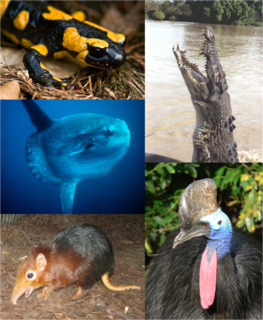
Vertebrates comprise all species of animals within the subphylum Vertebrata. Vertebrates represent the overwhelming majority of the phylum Chordata, with currently about 69,276 species described. Vertebrates include the jawless fishes and jawed vertebrates, which include the cartilaginous fishes and the bony fishes. The bony fishes in turn, cladistically speaking, also include the tetrapods, which include amphibians, reptiles, birds and mammals.
Bjerring's research is mainly about the fundamental structure of the head in vertebrate evolution. His studies are based on detailed analyses of models of the crania of the sarcopterygian fishes Eusthenopteron foordi and Glyptolepis groenlandica from the Devonian as well as serially-sectioned embryos of fishes and urodeles. He belongs to the Stockholm school of paleontology together with, among others, Erik Stensiö, Erik Jarvik, Gunnar Säve-Söderbergh, and Tor Ørvig.

A head is the part of an organism which usually includes the ears, brain, forehead, cheeks, chin, eyes, nose, and mouth, each of which aid in various sensory functions such as sight, hearing, smell, and taste, respectively. Some very simple animals may not have a head, but many bilaterally symmetric forms do, regardless of size.

Evolution is change in the heritable characteristics of biological populations over successive generations. These characteristics are the expressions of genes that are passed on from parent to offspring during reproduction. Different characteristics tend to exist within any given population as a result of mutation, genetic recombination and other sources of genetic variation. Evolution occurs when evolutionary processes such as natural selection and genetic drift act on this variation, resulting in certain characteristics becoming more common or rare within a population. It is this process of evolution that has given rise to biodiversity at every level of biological organisation, including the levels of species, individual organisms and molecules.

Eusthenopteron is a genus of prehistoric sarcopterygian which has attained an iconic status from its close relationships to tetrapods. The name derives from two Greek stems—eustheno- "strength" and -pteron "wing" and thus "strongly developed fins". Early depictions of this animal show it emerging onto land; however, paleontologists now widely agree that it was a strictly aquatic animal. The genus Eusthenopteron is known from several species that lived during the Late Devonian period, about 385 million years ago. Eusthenopteron was first described by J. F. Whiteaves in 1881, as part of a large collection of fishes from Miguasha, Quebec. Some 2,000 Eusthenopteron specimens have been collected from Miguasha, one of which was the object of intensely detailed study and several papers from the 1940s to the 1990s by paleoichthyologist Erik Jarvik.
A recurrent theme in Bjerring's research is that much of the vertebrate head is formed by a complex intertwining of serially homologous anatomical segments. [1] According to Bjerring, this holds both for the distribution and composition of cranial nerves, [2] [3] [4] [5] the pharyngeal arches and their contributions to the braincase [6] [7] [8] [9] [10] organs and structures derived from the pharyngeal clefts [11] as well as muscles and cartilages at the base of the skull. [12]

In biology, homology is the existence of shared ancestry between a pair of structures, or genes, in different taxa. A common example of homologous structures is the forelimbs of vertebrates, where the wings of bats, the arms of primates, the front flippers of whales and the forelegs of dogs and horses are all derived from the same ancestral tetrapod structure. Evolutionary biology explains homologous structures adapted to different purposes as the result of descent with modification from a common ancestor. The term was first applied to biology in a non-evolutionary context by the anatomist Richard Owen in 1843. Homology was later explained by Charles Darwin's theory of evolution in 1859, but had been observed before this, from Aristotle onwards, and it was explicitly analysed by Pierre Belon in 1555.
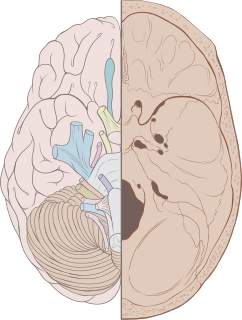
Cranial nerves are the nerves that emerge directly from the brain, in contrast to spinal nerves. 10 of the cranial nerves originate in the brainstem. Cranial nerves relay information between the brain and parts of the body, primarily to and from regions of the head and neck.

Branchial arches, or gill arches, are a series of bony "loops" present in fish, which support the gills. As gills are the primitive condition of vertebrates, all vertebrate embryos develop pharyngeal arches, though the eventual fate of these arches varies between taxa. In jawed fish, the first arch develops into the jaws, the second into the hyomandibular complex, with the posterior arches supporting gills. In amphibians and reptiles, many elements are lost including the gill arches, resulting in only the oral jaws and a hyoid apparatus remaining. In mammals and birds, the hyoid is still more simplified.
Bjerring has also discussed a number of classical problems in comparative anatomy. Like Erik Jarvik, he has argued that the three ear ossicles of mammals can be derived from components of the hyoid branchial arch of osteolepiforms rather than from both the mandibular and hyoid arches as claimed by the Reichert–Gaupp theory. [13] [14] Another classical problem is which one of two pairs of large dermal bones in the skull roof of sarcopterygian fishes that is homologous to the parietal bone of tetrapods. Here, Bjerring has proposed that neither alternative is correct; rather, the confusion may stem from the fact that, owing to the enormous expansion of the telencephalon in therians, one of the bone pairs has been displaced and forms the tentorium cerebelli below the skull roof. [15] He has also analysed the basic structure of the paired limbs by comparing the pectoral and pelvic fins of the Eusthenopteron with the hindleg of the Devonian tetrapod Ichthyostega and embryonic humans. [16]

Comparative anatomy is the study of similarities and differences in the anatomy of different species. It is closely related to evolutionary biology and phylogeny.

Anders Erik Vilhelm Jarvik was a Swedish paleontologist who worked extensively on the sarcopterygian fish Eusthenopteron. In a career that spanned some 60 years, Jarvik produced some of the most detailed anatomical work on this fish, making it arguably the best known fossil vertebrate.
A dermal bone or membrane bone is a bony structure derived from intramembranous ossification forming components of the vertebrate skeleton including much of the skull, jaws, gill covers, shoulder girdle and fin spines rays (lepidotrichia), and the shell. In contrast to endochondral bone, dermal bone does not form from cartilage that then calcifies, and it is often ornamented. Dermal bone is formed within the dermis and grows by accretion only – the outer portion of the bone is deposited by osteoblasts.
Bichirs are a small group of aberrant bony fish whose anatomy has been explored by Bjerring. He identified a pair of intracranial ligaments that hold their brains in place, [17] variations in the structure of the vomer, [18] the structure of the olfactory organ in bichir embryos, [19] and reported a spinobulbar cistern resembling the cerebellomedullar cistern of mammals. [20] Bjerring has disputed the common view that bichirs are actinopterygians, mainly because some alleged homologies between the cranial bones of bichirs and actinopterygians are dubious. [21] [22]
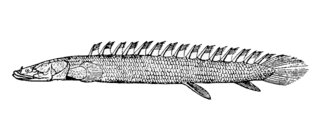
Bichirs and the reedfish comprise Polypteridae, a family of archaic-looking ray-finned fishes and the only family in the order Polypteriformes.
A ligament is the fibrous connective tissue that connects bones to other bones. It is also known as articular ligament, articular larua, fibrous ligament, or true ligament. Other ligaments in the body include the:
Bjerring has named the temnospondyls Selenocara [23] and Aquiloniferus [24] from the Lower Triassic of East Greenland. His papers are richly illustrated and characterized by a pregnant, sometimes polemic style. [25] He has also written popular scientific articles. [26] [27] [28]
Selenocara is an extinct genus of mastodonsauroid temnospondyl. The type species is Selenocara groenlandica, described by Gunnar Säve-Söderbergh in 1935 on the basis of skull bones from the Lower Triassic Wordie Creek Formation of Greenland. Säve-Söderbergh originally described it as a new species of Wetlugasaurus.
The Triassic is a geologic period and system which spans 50.6 million years from the end of the Permian Period 251.9 million years ago (Mya), to the beginning of the Jurassic Period 201.3 Mya. The Triassic is the first and shortest period of the Mesozoic Era. Both the start and end of the period are marked by major extinction events.

Greenland is an autonomous constituent country of the Kingdom of Denmark between the Arctic and Atlantic oceans, east of the Canadian Arctic Archipelago. Though physiographically a part of the continent of North America, Greenland has been politically and culturally associated with Europe for more than a millennium. The majority of its residents are Inuit, whose ancestors began migrating from the Canadian mainland in the 13th century, gradually settling across the island.
